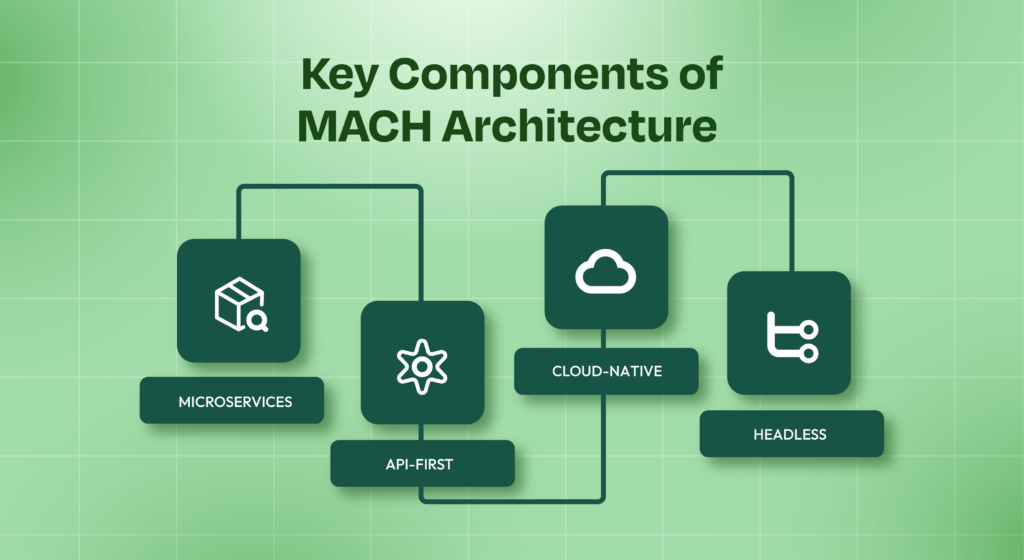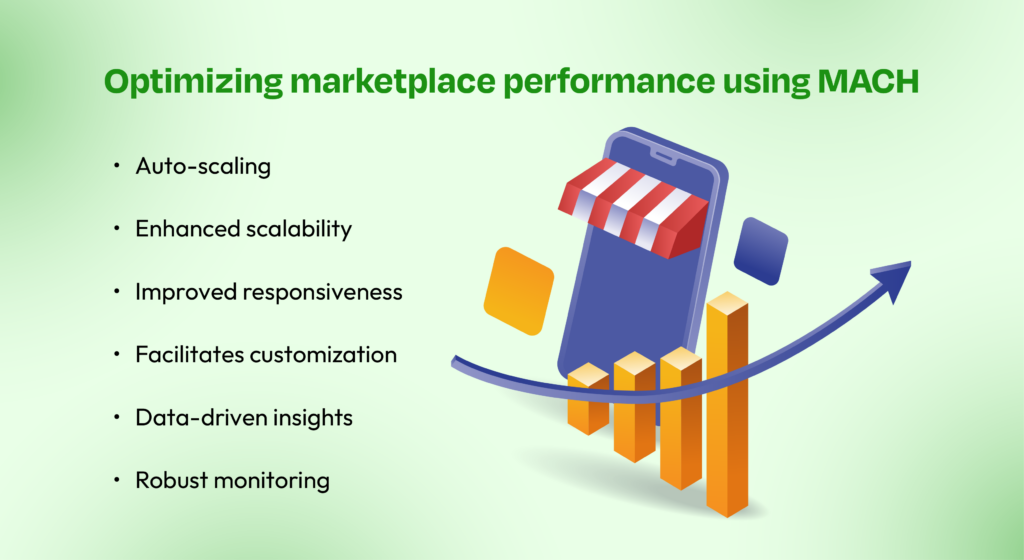Key Highlights
-
- MACH architecture allows businesses to build modern and agile marketplace that deliver exceptional digital experiences.
-
- By leveraging microservices, APIs, cloud-native technologies, and a headless CMS, MACH architecture enables organizations to achieve unparalleled flexibility, scalability, and speed.
-
- With its modular and composable structure, MACH empowers businesses to adapt swiftly to evolving market demands and customer expectations.
-
- MACH architecture promotes using best-of-breed technologies, allowing companies to select the most effective tools for their specific needs.
-
- This approach fosters innovation, reduces time-to-market for new features, and enhances overall marketplace performance, ultimately leading to improved customer satisfaction and business growth.
Today’s fast-paced digital marketplace isn’t just about what you sell – it’s about how you sell it. The overall success of the marketplace depends on meeting customer’s expectations – fast-loading pages, smooth navigation, and personalized experiences. A single bad interaction can mean losing a shopper for good.
That’s why more businesses are turning to MACH architecture—a modern approach built for better performance and effortless scaling. Unlike traditional monolithic architecture, MACH architecture empowers a modern approach to keep up with the demands for flexibility, scalability, and speed. It empowers ecommerce platforms to deliver a seamless and engaging experience to customers across various platforms. For marketplaces, this translates to seamless product searches, smooth purchase journeys, and hassle-free returns.
In this blog post, we will explore the intricacies of MACH architecture, its key components, benefits, and how its implementation can enable marketplaces to overcome technical limitations and thrive in an ever-changing environment.
What is MACH Architecture?
MACH, which stands for Microservices, API-first, Cloud Native SaaS, and Headless, is a new way to develop software, prioritizing modularity, flexibility, and scalability. MACH architecture separates functionalities into independent, API- connected services, enabling businesses to select the best tools for each task, adapt quickly, and scale efficiently without system-wide overhauls.
By leveraging cloud-native solutions and headless principles, this framework helps to build applications that remain resilient, future-ready, and capable of delivering seamless customer experiences across digital platforms.
Gartner has predicted that by 2027, over 60% of new cloud-based B2C and B2B digital commerce solutions will adhere to MACH architecture principles.
While monolithic systems have their own benefits, they are rigid, and a tough to scale approach causes downtime—something that no business wants. That’s where MACH architecture steps in, an adaptable and scalable modular approach. delivering great experiences for ecommerce marketplace solutions.

Key Components of MACH Architecture
MACH architecture uses separate services, instead of a one-piece codebase, making the overall development process less complicated and more agile. Let’s dive into the key principles of this approach to understand how MACH architecture works for marketplace platforms.
1. Microservices Architecture
Microservices are small, independent services that handle a specific business function. Unlike a monolith system, where all the systems gain dependencies, microservice break the application into small, independent parts. Each part runs alone and talks to the others over a network.
Each microservices operates in its own process and communicates with others over lightweight protocols like HTTP or messaging queues. If one microservice changes or is updated, it won’t affect the entire system.
This modular approach allows teams to develop, deploy, and scale services independently, enhancing flexibility and maintainability.Hence, MACH architecture speeds up the development process and helps in making quick updates.
2. API-first
MACH architecture adopts an API-first approach, where APIs play a central role in enabling communication between different services. Each microservice exposes its functionalities through clear APIs, enabling seamless integration.
This approach offers flexibility, easier maintenance, and simplified external platform integration. APIs act as a bridge, ensuring that all components within the MACH architecture work together seamlessly.
Additionally, an API-first approach allows businesses to build new applications or digital experiences without overhauling the existing system.
3. Cloud Infrastructure
MACH architecture harnesses cloud-native infrastructure to scale on-demand resources, making it cost-effective and resilient.
Cloud-native applications are designed to work optimally in the cloud, often built as microservices packaged in containers and managed with orchestration tools. You can choose the cloud platform that can easily grow and adapt without the need for complex, on-premise infrastructure. They take advantage of the benefits of cloud services, like AWS, Azure, or Google Cloud.
This model ensures that applications can handle fluctuating traffic without compromising performance, providing the flexibility and strength needed for modern, scalable business operations.
4. Headless Approach
Headless separates the frontend presentation layer from the backend logic, offering developers freedom to choose the best frontend framework for their needs, like React or Vue.js.
Backend systems like CMS, e-commerce platforms, and CRMs work independently, exposing data via APIs. This decoupling allows businesses to deliver content quickly across multiple platforms without the limitations of a traditional monolithic system.
You can create customized user experiences while allowing marketers to manage content independently, enhancing user engagement and providing a more dynamic and flexible solution.

Check out Revamping Anot Architect’s Online Image: A Website Redesign Case Study.
The Benefits of Adopting MACH Architecture for Ecommerce
Adopting MACH architecture has several advantages for businesses. The flexible approach of this architecture allows customization of technology stack, encouraging innovation and agility.
Here’s the benefits of MACH architecture on your marketplace operations.
Increasing Speed and Efficiency
MACH architecture significantly boosts development speed and efficiency by breaking down complex tasks into manageable components. This module enables developers to work independently on specific features or functions, fix bugs faster, increasing speed and efficiency in development.
Continuous integration and delivery are core at MACH, ensuring faster rollouts of new features and updates. Hence, the quick response of MACH architecture aligns well with the fast- paced demands of modern software development.
Customer oriented approach with MACH Architecture
MACH architecture is designed with a core focus on the customer, enabling businesses to create unique customer journeys across multiple touch-points. This approach allows rapid A/B testing, enabling them to experiment with various features and user interfaces for specific customer segments.
The complete view of custom behavior gained from such tests can help to improve the customer experience, leading to better engagement, higher conversion rates, and increased satisfaction.
Enhanced web performance
MACH architecture uses cloud infrastructure, CDNs and efficient caching, making websites and apps load faster. This means quick page load speed, lowers bounce rates and keeps users engaged.
It also enhances user experience with personalized content tailored to individual preferences, boosting customer loyalty and driving sales. In today’s digital world, MACH ensures smooth, responsive experiences that meet user expectations and help businesses grow.
Faster time-to-market
To stay competitive, businesses must launch new products, services, and features quickly, and MACH architecture makes it possible. The microservices, one of the key principles, allows development teams to work on independent components, simultaneously.
New features can be created, tested, and deployed without needing major changes to the entire application, reducing delays. Hence, this approach along with third-party integrations, accelerates turning ideas into market- ready products.
Flexible tool selection with MACH Architecture
Instead of using a one-size-fits-all software suite, MACH allows companies to select and combine the best software tools for each task. While developing the application, you can select individual tools based on the criteria of the particular module.
The API-first approach facilitates seamless integration and easy updates to adapt with the newest technologies based on need. Additionally, using the best tools boosts innovation and agility.
Seamless automatic upgrades
With MACH, updates can happen in small steps, lowering the risks tied to old software updates that can cause big changes. Moreover, each service can be updated on its own, which reduces downtime.
Also, in a MACH setup, automatic upgrades promote continuous delivery and robust monitoring tools. The flexible approach lets organizations customize their technology stack to fit their specific needs. Overall, this boosts the system’s reliability and enhances the user experience.
Here’s a case study on Auto24: Building Africa’s Used Car Marketplace for Success.
A Step-by-Step Guide to build a marketplace with MACH Architecture
Building a marketplace with MACH architecture can make development more flexible, scalable, and quick to adapt. This agility not only enhances competitive positioning but also fosters exceptional customer experience through personalized interactions. However, as companies navigate this transition, careful planning and execution are essential to maximize the benefits of MACH architecture.
Here’s the necessary steps to adopt MACH architecture effectively, ensuring your business can thrive in the digital landscape.
Step 1: Define your marketplace vision
Start by defining your business goals and the unique value you want to offer. Consider your target audience and the essential features that will resonate with them such as search capabilities, product pages, user reviews, and seller management tools. This foundational step is crucial as it informs the design and functionality of your marketplace. A clear vision will guide your decisions and ensure that every component aligns with your overall strategy.
Step 2: Choose the right MACH components and tech stack
Once you’ve defined your requirements, select technologies that follow MACH principles. Use platforms like AWS or Azure for hosting, microservices for specific tasks like payment processing, and a headless CMS for content management. This modular approach customizes your tech stack to meet your marketplace needs.
Moreover, research potential vendors with proven expertise and check their reviews on platforms like Clutch. Asterdio, for instance, specializes in modular architecture. Our team of experienced developers uses advanced tech stacks for marketplace development, ensuring your application is scalable, efficient, and user-friendly.
Step 3: Design the microservices architecture
The next step is to begin building out your microservices, focusing on core functionalities such as user authentication, product catalog management, and order processing. Such architecture allows your tech team to manage each function independently. Each microservice should have its own dedicated database to prevent data conflicts, communicate seamlessly through APIs to maintain smooth operations across the platform.
This is one of the major benefits of building a marketplace using MACH architecture, as if one service needs scaling—say, during a holiday sale—you can do so without affecting the rest of the system. It’s all about agility!
Step 4: Implement API-first development
Establish a robust API-first approach to connect your frontend and backend effectively. Define the API structure upfront, detailing data flow and response handling, then choose a gateway to manage your APIs effectively.
Consider using API gateways like AWS API Gateway or NGINX to manage requests, load balancing, enhance security, and improve performance. At Asterdio, based on the MACH approach, we integrate third-party services and APIs. We ensure all components of your marketplace work cohesively, providing a seamless user experience.
Step 5: Deploy a cloud-native infrastructure
This step ensures deploying your microservices within a cloud-native infrastructure. Utilize containerization with Docker for isolation of each microservice and employ orchestration tools like Kubernetes to manage these containers efficiently, ensuring smooth interactions between services.
You can further leverage cloud-native database and storage solutions, to handle tasks like scaling or backups. Use cloud-native databases like AWS RDS for data management and AWS S3 for storage solutions to handle images and videos effectively. Hence, each of these aspects are vital for marketplace microservices deployment.
Step 6: Develop headless architecture
Now that your backend is set up, develop a headless frontend that can interact with your microservices via APIs. This allows for a user interface tailored to different audience segments, enabling rapid experimentation with designs and features. You can utilize modern JavaScript frameworks for enhanced performance and responsiveness.
We recommend a modular development strategy to select the best tools for each function, ensuring scalability and maintainability. Our team can assist you in API design and integration strategies, helping you build a dynamic shopping platform that adapts to user needs and market trends effectively.
Step 7: Launch and Optimize your marketplace
Once everything is in place, it’s time to launch! But don’t stop there—integrate monitoring tools for real-time insights into system performance and user behavior. This proactive approach enables you to quickly identify issues and optimize the experience based on user feedback. Regularly analyze performance data to understand user interactions and preferences.
Furthermore, iterate on features and introduce new ones as market demands evolve. We recommend you to optimize your marketing efforts, focusing on SEO and community engagement to attract and retain users effectively.
Optimizing Marketplace Performance with MACH Architecture
The surge in online shopping requires marketplaces to deliver top-notch performance for success. Market demands dynamic platforms that can facilitate scalability, flexibility, and exceptional user experiences to thrive in a competitive landscape.
Implementing MACH architecture can revolutionize your e-commerce platform by enhancing speed, responsiveness, and reliability. Each element of MACH is designed to maximize performance, enabling seamless operations and real-time adaptability to changing customer preferences.
By focusing on these core aspects, you can create personalized shopping experiences that resonate with your audience, build lasting loyalty, and drive sustainable growth in the competitive e-commerce landscape.
Here’s how MACH architecture offers a robust solution for optimizing marketplace performance.
1. Auto-scaling with MACH Architecture
Cloud setups automatically adjust resources based on demand. This means that as traffic increases, additional resources are allocated in real-time, preventing slowdowns or crashes.
For example, Alibaba’s infrastructure can process over 544,000 orders per second during peak times due to its auto-scaling capabilities.
2. Enhanced scalability
Microservices architecture offers significant benefits through its ability to scale individual components independently. Each function, such as payment processing or user authentication, operates independently. This targeted approach not only enhances performance, but also improves resource efficiency, as resources are allocated on demand.
For instance, during peak traffic events, such as holiday sales, a marketplace can scale its payment service independently to handle increased transactions without slowing down other services.
3. Improved responsiveness
Utilizing cloud resources enhances a marketplaces’ ability to manage traffic spikes effectively, allowing for real-time resource allocation. For example, during major sales events like Amazon Prime Day, the cloud infrastructure allows the application to accommodate millions of visitors, ensuring a seamless shopping experience even under heavy loads. This capability prevents slowdowns and maintains user satisfaction even under heavy loads.
4. Facilitates customization
Headless architecture separates the front-end from the back-end, allowing marketplace to create highly customizable user interfaces tailored to different audience segments. Marketplaces can quickly adapt their front-end experiences based on user behavior and preferences.
The customization empowers businesses to enhance the shopping experience across various channels, meeting diverse customer needs effectively.
5. Data-driven insights
Unified APIs play a crucial role in enhancing user-engagement by collecting data from various sources to provide insights into user behavior. This enables marketplaces to deliver personalized recommendations and targeted promotions. The A/B testing insights further allows us to test variations in features,and find what’s working best through data driven insights.
For example, Netflix uses a unified APIs to analyze viewing habits and suggest movies that aligns with the user’s interests, significantly increasing viewer retention and satisfaction.
6. Robust monitoring with MACH Architecture
Integrated monitoring tools are essential for maintaining system reliability and performance, enabling quick identification and resolution of issues. They provide real-time insights that facilitate the quick identification and resolution of issues before they escalate.
For instance, tools like Middleware.io, Datadog and Dynatrace offer advanced monitoring capabilities that alert teams to performance bottlenecks. This proactive approach ensures that your ecommerce applications can handle increased user activity without compromising service quality or user experience.

How to evaluate MACH architecture?
Before starting the process of using MACH architecture, businesses should check whether it aligns with their needs or not. For instance, you should first assess your current technology stack and find areas where MACH can provide better results. Furthermore, define business function priorities during the implementation to ensure a quick and effective transition.
Factors to consider when evaluating potential MACH architecture
| Factors | Description |
| Modularity | Verify the architecture can be broken down into small, independent modules to facilitate development, testing, and deployment processes. |
| API-First | Ensure every component can communicate with others through well-defined APIs for seamless integration and flexibility. |
| Cloud-Native | The architecture should be designed to leverage cloud infrastructure for scalability, resilience, and cost-efficiency. |
| Headless Functionality | Ensure a true separation between the frontend and backend, allowing flexibility in choosing frontend frameworks and delivering content to multiple channels. |
| Scalability and Performance | Evaluate how well the architecture can handle increasing traffic and data volumes without compromising speed or stability. |
| Security | Assess the security measures in place to protect sensitive data and ensure compliance with industry standards. |
| Vendor Support and Community | Consider the availability of reliable vendor support, documentation, and a vibrant developer community for assistance and resources. |
| Cost-Effectiveness | Analyze the overall cost of ownership, including infrastructure, development, maintenance, and potential licensing fees |
| Integration Capabilities | Evaluate how easily the architecture can integrate with existing systems, third-party tools, and future technologies to avoid vendor lock-in. |
| Customization and Flexibility | Assess the architecture’s ability to adapt to your specific business requirements and support future growth and innovation. |
| Developer Experience | Consider the ease of use, tooling, and overall development experience the architecture offers, impacting development speed and team productivity. |
To Wrap Up
Adopting MACH architecture digitally transforms your business platforms, emphasizing flexibility, scalability, and speed. But it can be challenging for teams used to traditional methods. Clear communication, training, and support are vital for a smooth transition. You can also opt for staff augmentation to get access to right talent.
To navigate these challenges effectively, our team simplifies the process by guiding the right technology selection, staff training, and ensuring seamless system integration. Let’s work together to future-proof your business with MACH architecture!
Frequently Asked Questions
What makes MACH Architecture different from other Web Development approaches?
The MACH approach is different from the old monolithic architecture. It focuses on composable architecture. In this setup, each part works on its own and links through APIs. This gives businesses greater flexibility and the ability to grow easily.
Can MACH Architecture be integrated with existing web platforms?
Yes, MACH technologies can be added to current platforms step by step. First, find the parts you want to move. Then, slowly replace them or link them using APIs.
How does MACH Architecture impact SEO and website performance?
MACH’s headless approach helps SEO by making websites perform better. It does this by reducing load times, which is very important for ranking. This method also allows for better content delivery to both search engines and users.
What are the initial costs involved in switching to MACH Architecture?
The first costs will vary based on how complex the project is and what technologies you choose. Still, the long-term benefits of MACH, such as faster changes and lower development costs, usually make up for the first investment.



